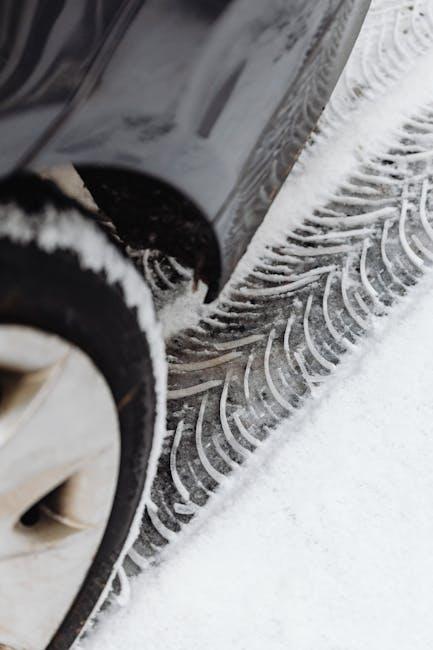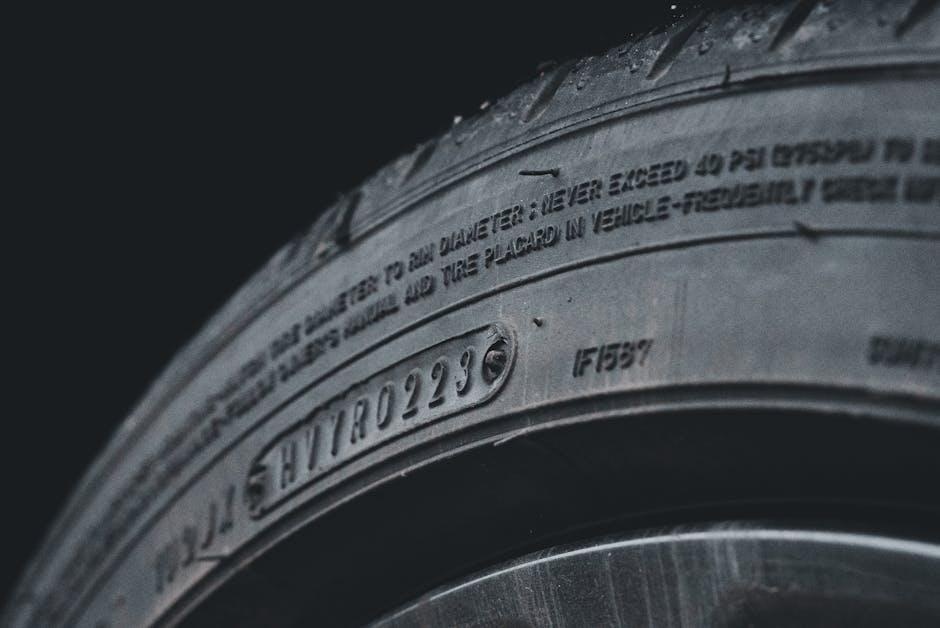Beneath every smooth drive lies an often-overlooked hero: the tire tread. These intricate patterns of rubber not only grip the road but also play a crucial role in your safety and vehicle performance. Knowing how to inspect tire tread depth is more than a routine check—it’s a proactive step toward preventing accidents, improving fuel efficiency, and extending the life of your tires. In this article, we’ll explore simple, effective ways to measure your tire tread depth, helping you stay informed and confident on the road.
Table of Contents
- Understanding the Importance of Tire Tread Depth for Safety
- Essential Tools and Methods for Measuring Tire Tread
- Step-by-Step Guide to Conducting a Thorough Tread Depth Inspection
- Interpreting Tread Depth Results and Knowing When to Replace Tires
- Tips for Maintaining Optimal Tread Depth Through Regular Care
- Common Tread Wear Patterns and What They Reveal About Your Tires
- Q&A
- Key Takeaways

Understanding the Importance of Tire Tread Depth for Safety
Maintaining adequate tire tread depth is critical for ensuring optimal vehicle performance and, most importantly, your safety on the road. Tread depth directly affects traction, enabling your tires to grip the road surface under various conditions, including wet, icy, or uneven terrain. When the tread wears down, the risk of hydroplaning on wet surfaces increases dramatically, reducing your control over the vehicle and extending stopping distances. It’s essential to recognize that tire tread isn’t just a wear factor — it’s the first line of defense against accidents caused by skidding or loss of grip.
Beyond the dangers, knowing when to replace your tires can save you money and avoid unnecessary risks. A simple, regular inspection using tools such as a tread depth gauge or even a penny can provide valuable insights into tire health. Here’s what to keep in mind:
- Legal limit: Most regions require a minimum tread depth of 2/32 inch (1.6 mm).
- Optimal safety depth: Experts recommend replacing tires by 4/32 inch, especially in wet conditions.
- Uneven wear indicators: Look for tread wear bars that appear flush with the tread surface.
| Condition | Safe Tread Depth (inches) |
|---|---|
| Dry Roads | 2/32 or more |
| Wet Conditions | 4/32 or more |
| Snow/Ice | 6/32 or more |

Essential Tools and Methods for Measuring Tire Tread
To accurately gauge the health of your tires, several practical tools can be used to measure tread depth. One of the most common and reliable instruments is the tread depth gauge, which provides precise readings in both 32nds of an inch and millimeters. Another popular method is the penny test, where inserting a penny into the grooves with Lincoln’s head upside down reveals the tread’s condition based on how much of the head is visible. For a quick, visual check, you can look for built-in tread wear indicators—small bars molded into the grooves of the tire that become flush with the tread surface once it’s worn down, signaling the need for replacement.
Using the right method can make a significant difference in safety and tire longevity. Below is a simple comparison of common measuring methods to help you decide which one suits your needs:
| Method | Ease of Use | Accuracy | Cost |
|---|---|---|---|
| Tread Depth Gauge | Moderate | High | Low |
| Penny Test | Easy | Moderate | Free |
| Visual Tread Wear Indicators | Easy | Low | Free |

Step-by-Step Guide to Conducting a Thorough Tread Depth Inspection
Begin by parking your vehicle on a flat, stable surface and ensuring the tires are cool to the touch. Gather necessary tools such as a tread depth gauge or even a simple penny can work as a preliminary measuring tool. Before measuring, make sure to remove any debris, stones, or dirt lodged in the tire grooves to get an accurate reading. Always inspect multiple points along the tire’s circumference, including the inner, center, and outer tread areas—tread wear can vary significantly across the tire’s surface and reveal hidden issues like alignment problems or improper inflation.
Use your tool to measure the tread depth by placing it into the grooves and reading the measurement at several points. For most passenger vehicles, tread depth below 2/32 of an inch (1.6mm) is considered unsafe. Here’s a quick guide for reference on what your readings indicate:
| Depth Measurement | Condition | Action Required |
|---|---|---|
| > 6/32 inch (5mm) | Good | Normal driving, regular inspections |
| 4/32 – 6/32 inch (3-5mm) | Moderate wear | Monitor closely, consider replacement soon |
| < 2/32 inch (1.6mm) | Unsafe | Immediate replacement necessary |
Repeat this process for every tire to ensure safe driving conditions. Keeping a consistent inspection routine enhances vehicle safety and may extend tire life by identifying uneven wear early on.

Interpreting Tread Depth Results and Knowing When to Replace Tires
When examining tire tread depth, it’s essential to recognize the signs that indicate whether your tires are still roadworthy or in need of replacement. A common baseline for adequate tread depth is 2/32 of an inch; anything less compromises traction and increases the risk of hydroplaning, especially on wet surfaces. Additionally, tire wear bars—those small raised sections running perpendicular to the tread—become flush with the tire’s surface when tread depth is dangerously low. Keep an eye out for uneven wear patterns, which might signal alignment problems or improper inflation, both reducing tire longevity and safety.
Knowing when to replace tires is just as crucial as knowing how to measure tread depth. Here’s a quick checklist to help decide if new tires are due:
- Tread depth below 2/32 inch: Legal minimum in most regions and a sign it’s time to replace.
- Cracks or bulges: Visible damage means serious safety risks.
- Frequent air pressure drops: Could indicate internal tire damage.
- Vibration while driving: May mean uneven wear or internal issues.
| Tread Depth | Condition | Action Needed |
|---|---|---|
| 6/32 inch or more | Excellent | No action required |
| 4/32 to 6/32 inch | Moderate wear | Plan for replacement |
| 2/32 to 4/32 inch | Worn | Replace soon |
| Less than 2/32 inch | Unsafe | Replace immediately |

Tips for Maintaining Optimal Tread Depth Through Regular Care
Keeping your tire tread at a healthy depth doesn’t have to be daunting. Start by performing regular visual inspections—aim to check your tires once a month and before long trips. Use a tread depth gauge or the classic penny test to monitor wear patterns consistently. Additionally, maintaining proper tire pressure is crucial, as underinflated or overinflated tires wear unevenly, reducing tread life and performance. Remember, evenly rotated tires extend longevity, so include rotation every 5,000 to 7,000 miles as part of your care routine.
Adopting a mindful driving style goes a long way in preserving tread health. Avoid sudden acceleration, sharp turns, and hard braking, which accelerate tread wear. In winter or wet conditions, increased traction demands call for even more diligence in tread checks. Here’s a quick snapshot to guide your maintenance frequency based on driving habits and conditions:
| Driving Style | Recommended Check Frequency |
|---|---|
| City Driving | Every 1 month |
| Highway Driving | Every 2 months |
| Off-road/Harsh Conditions | Every 2 weeks |

Common Tread Wear Patterns and What They Reveal About Your Tires
Understanding the different ways your tires wear can offer valuable insights into the health of your vehicle’s suspension, alignment, and inflation. For instance, center tread wear often indicates over-inflation, where the tire bulges out and wears faster in the middle. Conversely, edge tread wear suggests under-inflation, causing excessive friction on the tire edges. Meanwhile, feathered tread wear or one-sided wear patterns often point to misalignment issues, which can compromise handling and safety if left unaddressed.
Recognizing these patterns early can prevent costly repairs and improve overall driving safety. Here’s a quick reference guide to common wear patterns:
| Wear Pattern | Cause | Effect |
|---|---|---|
| Center Wear | Over-Inflation | Reduced tread life, less grip |
| Edge Wear | Under-Inflation | Poor handling, overheating |
| Feathered Edges | Misalignment | Choppy ride, uneven grip |
| Patchy or Cupping | Worn Suspension | Vibration, noise |
Q&A
Q&A: How to Inspect Tire Tread Depth
Q1: Why is checking tire tread depth important?
A1: Tire tread depth is crucial for maintaining good traction, especially on wet or slippery roads. Adequate tread helps channel water away, reducing the risk of hydroplaning and improving your vehicle’s overall safety and performance.
Q2: How do I know when my tire tread is too worn?
A2: Most experts recommend replacing tires when tread depth reaches 2/32 of an inch (about 1.6 mm). At this point, tires no longer provide sufficient grip, increasing stopping distances and compromising control.
Q3: What tools can I use to measure tread depth?
A3: The classic tool is a tread depth gauge, a small device designed specifically for the job. If you don’t have one, a common alternative is using a U.S. penny: insert it into the tread with Lincoln’s head upside down. If you can see the top of his head, it’s time to replace the tire.
Q4: How do I perform a tread depth inspection step-by-step?
A4: First, park on a flat surface and turn off the car. Insert your tread depth gauge or penny into the tread grooves at multiple points around each tire. Measure across different spots to check for uneven wear. If any measurement is at or below 2/32 inch, consider tire replacement.
Q5: Can I visually estimate tread depth without tools?
A5: While you can look for signs like smooth patches or low tread bars molded into the tire, these indicators aren’t as reliable as actual measurements. When in doubt, using a gauge or penny test provides more confidence.
Q6: How often should I check my tire tread?
A6: Checking tread depth every 3,000 to 5,000 miles or at every oil change is a good habit. Regular inspection helps catch wear early and prevents unsafe driving conditions.
Q7: Does tire tread depth impact fuel efficiency?
A7: Yes, tires with worn tread can affect rolling resistance, potentially lowering fuel efficiency. Keeping your tires in good condition optimizes both safety and gas mileage.
Q8: Should I inspect all four tires the same way?
A8: Absolutely. Wear can differ between tires due to alignment or driving habits. Checking all four ensures you don’t miss uneven wear that could affect handling.
Q9: What if my tread depth is borderline?
A9: If the tread is close to the minimum depth, monitor it more frequently and drive cautiously. Plan to replace the tires soon to maintain safety.
Q10: Where can I get professional help if I’m unsure?
A10: Most tire shops and auto service centers offer free or low-cost tread inspections. Professionals can provide detailed assessments and recommend if replacement or maintenance is needed.
By regularly inspecting your tire tread depth, you contribute to safer journeys and better vehicle performance. A small check today can prevent big problems tomorrow!
Key Takeaways
Whether you’re gearing up for a long road trip or simply driving your daily route, keeping an eye on your tire tread depth is a small habit that pays off in big ways. By mastering the simple steps to inspect your tires, you’re not just maintaining your vehicle—you’re safeguarding your journey. Remember, those grooves beneath your wheels are the silent guardians of traction and control. So, next time you glance down, take a moment to measure—and drive with confidence, knowing you’ve got the road covered, one tread at a time.

